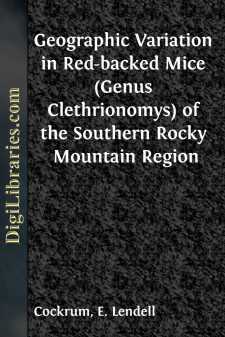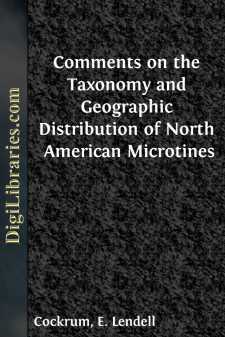Categories
- Antiques & Collectibles 13
- Architecture 36
- Art 48
- Bibles 22
- Biography & Autobiography 813
- Body, Mind & Spirit 142
- Business & Economics 28
- Children's Books 15
- Children's Fiction 12
- Computers 4
- Cooking 94
- Crafts & Hobbies 4
- Drama 346
- Education 46
- Family & Relationships 57
- Fiction 11828
- Games 19
- Gardening 17
- Health & Fitness 34
- History 1377
- House & Home 1
- Humor 147
- Juvenile Fiction 1873
- Juvenile Nonfiction 202
- Language Arts & Disciplines 88
- Law 16
- Literary Collections 686
- Literary Criticism 179
- Mathematics 13
- Medical 41
- Music 40
- Nature 179
- Non-Classifiable 1768
- Performing Arts 7
- Periodicals 1453
- Philosophy 64
- Photography 2
- Poetry 896
- Political Science 203
- Psychology 42
- Reference 154
- Religion 513
- Science 126
- Self-Help 84
- Social Science 81
- Sports & Recreation 34
- Study Aids 3
- Technology & Engineering 59
- Transportation 23
- Travel 463
- True Crime 29
A New Pocket Mouse (Genus Perognathus) from Kansas
Description:
Excerpt
In studying the kinds of mammals known from Kansas, I had occasion to examine a series of Perognathus flavus from the western part of the state. Comparisons of these specimens with topotypes of named subspecies revealed that the specimens from Kansas belong to a heretofore undescribed subspecies which ranges through western Nebraska, eastern Colorado, western Kansas, and western Oklahoma. This subspecies is named and described as follows.
Perognathus flavus bunkeri, new subspecies
Type.—Female, adult, skin and skull; No. 11716, Univ. Kansas Mus. Nat. Hist.; Conard Farm, 1 mi. E Coolidge, Hamilton County, Kansas; 1 July 1936; obtained by F. Parks and C. W. Hibbard, original No. 894 of Hibbard.
Diagnosis.—Size large (see measurements). Color light, upper parts between Pinkish Buff and Cinnamon-Buff (capitalized color terms after Ridgway, Color Standards and Color Nomenclature, Washington, D. C., 1912), sparsely mixed with black hairs; the effect at a distance of eight feet, is between Clay Color and Tawny-Olive; lateral line between Pinkish Buff and Cinnamon-Buff; postauricular spots near Pinkish Buff; small subauricular spots white; underparts white. Skull of medium size (see measurements); frontonasal and mastoidal regions much enlarged; interparietal transversely narrow.
Comparisons.—From topotypes of P. f. flavus from El Paso, El Paso County, Texas, P. f. bunkeri differs as follows: Averaging larger in all cranial measurements taken except in occipitonasal length, which is approximately the same, and in interparietal width, which is less; color more buffy, with fewer black hairs dorsally. From topotypes of P. f. piperi from 23 miles southwest of Newcastle, Weston County, Wyoming, P. f. bunkeri differs as follows: Smaller in frontonasal length, mastoidal breadth, and length of auditory bulla; color more buffy, with fewer black hairs dorsally. From topotypes of P. f. sanluisi from nine miles east of Center, Alamosa County, Colorado, P. f. bunkeri differs as follows: Averaging larger in all cranial measurements taken except interparietal width, which is smaller; color lighter and more buffy.
Remarks.—This is a brightly colored subspecies of Perognathus flavus, with less black dorsally than any adjacent one. The lateral line is well marked. Three young adult specimens taken from Wakeeney, Trego County, Kansas, are much brighter than other specimens from Kansas. The five specimens from Greeley, Weld County, Colorado, are much darker dorsally, like P. f. piperi, but are referable to P. f. bunkeri on the basis of cranial characters.
The name P. f. bunkeri is proposed in recognization of the continued attention which the late Charles Dean Bunker, Curator of Birds and Mammals of the University of Kansas Museum of Natural History, gave to building up the collection of mammals from Kansas. Acknowledgment is made of the assistance afforded me by a Research Assistantship with the Kansas Biological Survey.
Measurements.—Measurements of holotype and average of four adults (two males and two females) from the type locality are as follows: total length, 104, 105.2; length of tail, 44, 47.5; length of hind foot, 16, 16.7; length of ear, 7, 7.2; occipitonasal length, 20.6, 20.9; frontonasal length, 14.0, 13.9; mastoidal breadth, 12.1, 12.0; length of bulla, 8.0, 7.8; interorbital breadth, 4.5, 4.6; alveolar length of upper molariform tooth-row, 3.3, 3.1; interparietal width, 3.2, 3.2. All of the measurements listed above are available for each of the five specimens except that the occipitonasal length and frontonasal length are not available for the two males....




